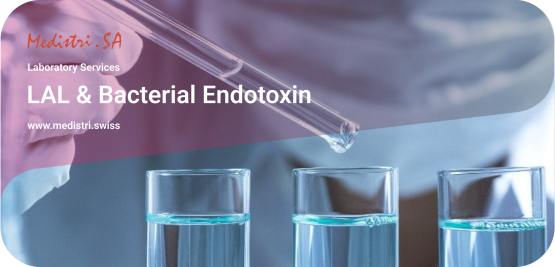(Download: LAL & Bacterial Endotoxin in PDF by Medistri)
The LAL (Limulus Amebocyte Lysate) testing, also known as bacterial endotoxin testing, is an in vitro assay used to detect the presence and concentration of bacterial endotoxins in drugs and biological products, and is an important part of pharmaceutical microbiology.
The reason the bacterial endotoxin test is also called LAL or limulus amebocyte lysate testing is because of the lysate from blood cells (amebocytes) from horseshoe crabs (the latin name is limulus Polyphemus) - the lysate from the horseshoe crabs blood cells react with bacterial endotoxins.
👉 Samples are mixed with the LAL reagent in a 96 well plate and a plate reader in order to measure how the color changes over time. The liquid in the wells becomes more yellow over time, and the rate of that color change is proportional to the amount of endotoxin present in the sample. The impact of inhibitory compounds has less of an impact using the kinetic chromogenic method than other methods. In addition, the kinetic chromogenic method is more sensitive than other LAL testing methods.
👉 The kinetic chromogenic LAL method is based on the measurement of color at different intervals of time after the addition of the chromogenic substrate (containing the LAL reagent and chromogenic reagent) to the test sample.
Endotoxins, which are a type of pyrogen, they’re also known as “lipopolysaccharides” — the major component of the outer membrane of Gram-negative bacteria. Pyrogens as a class are fever-inducing substances that can be harmful or even fatal if administered to humans above certain concentrations. Medistri SA has accreditation STS 504 for endotoxin analysis, both in routine test that validation.
👉 The purpose of the validation of bacterial endotoxins is to check the sensitivity of the lysate in the presence of the product to ensure that it does not differ significantly from its sensitivity in the absence of it. Bacterial Endotoxin testing allows manufacturers to determine if the proposed product does not present interference factors which may result in false negatives or false positives, this taking into account the maximum dilution at which samples can be determined.
Endotoxins can be detected in injectable pharmaceuticals, implantable medical devices and pharmaceutical packagings through bacterial endotoxin testing (BET). The most popular bacterial endotoxin test uses LAL (limulus amebocyte lysate) to test for bacterial endotoxins.
✔ The tests are performed according to the European Pharmacopoeia and the harmonised text of the current pharmacopoeia (European, American and Japanese ). Tests AAMI meet the recommendations. All types of samples can be tested:
- Raw materials.
- Finished products.
- Sample dialysis.
- Medical and surgical equipment.
👉 The method used here is the kinetic colorimetry.
🎯 To learn more about Medistri’s LAL & Bacterial Endotoxin tests, visit on our website at https://www.medistri.swiss/lal-bacterial-endotoxin or directly contact our team at contact@medistri.swiss.
- The Medistri Team
#Medistri
Medistri’s Laboratory Services: https://www.medistri.swiss/laboratory
